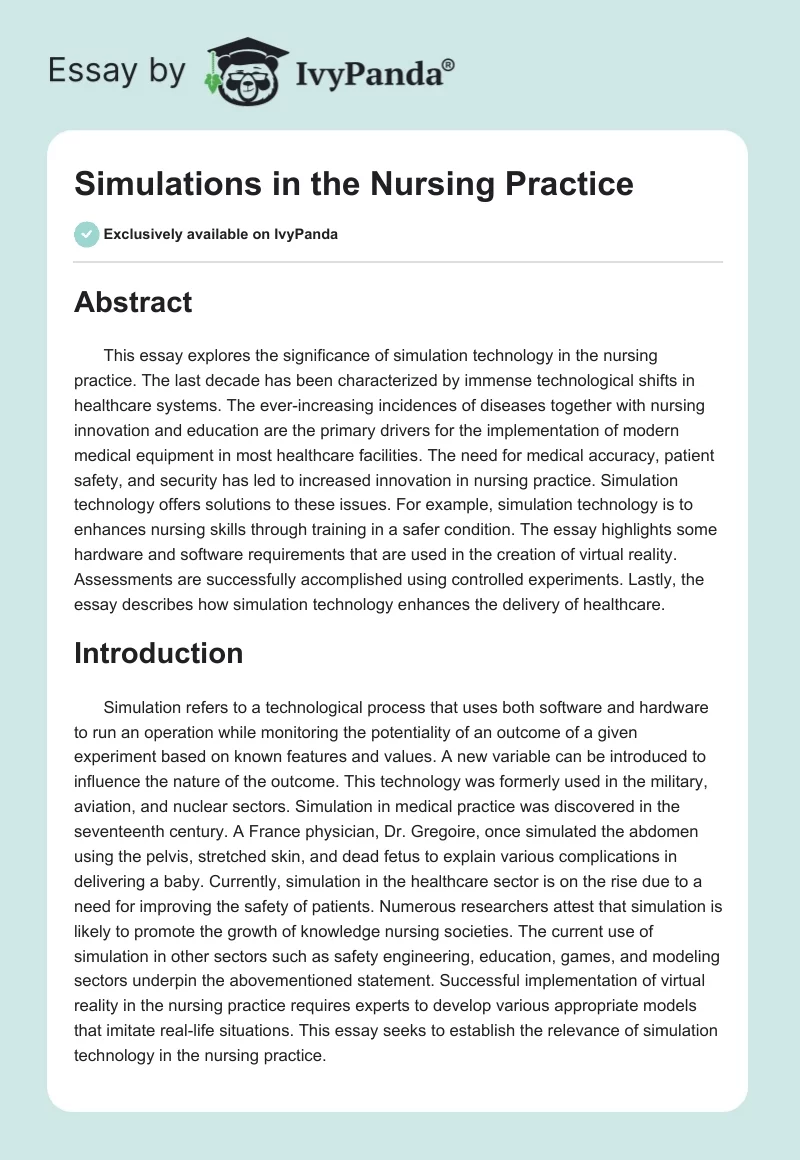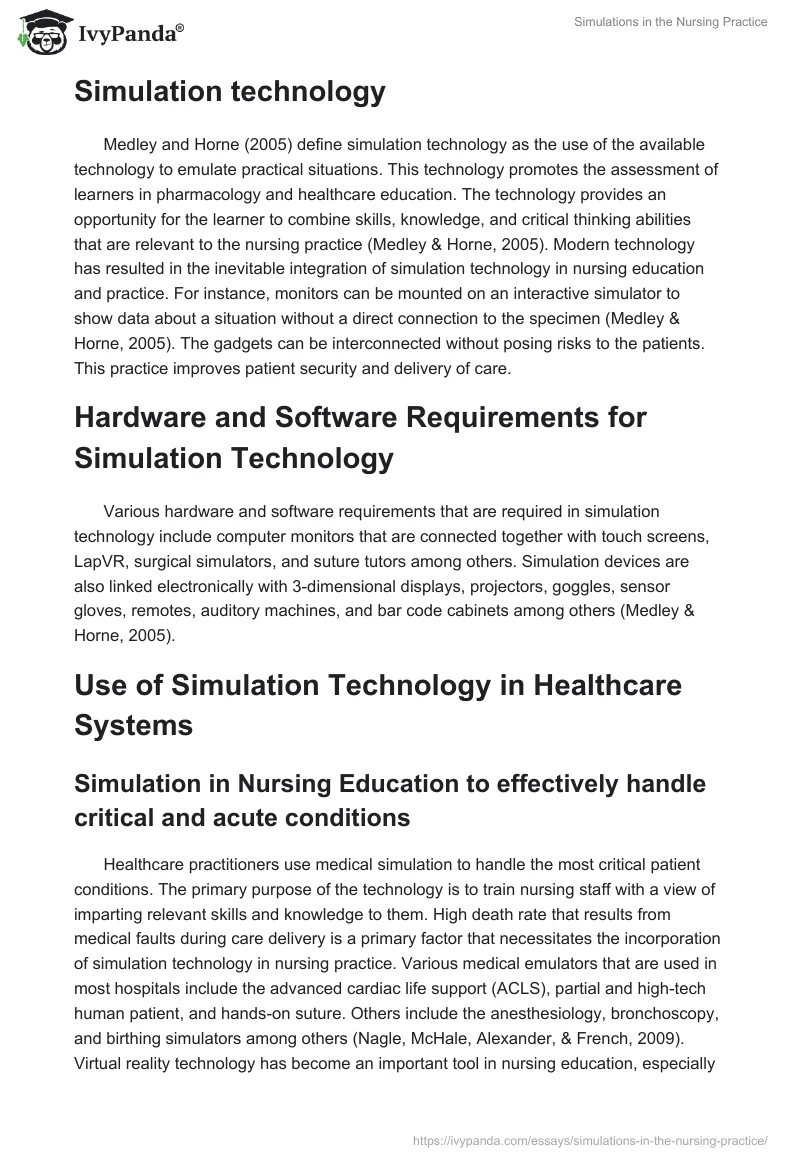Abstract
This essay explores the significance of simulation technology in the nursing practice. The last decade has been characterized by immense technological shifts in healthcare systems. The ever-increasing incidences of diseases together with nursing innovation and education are the primary drivers for the implementation of modern medical equipment in most healthcare facilities. The need for medical accuracy, patient safety, and security has led to increased innovation in nursing practice. Simulation technology offers solutions to these issues. For example, simulation technology is to enhances nursing skills through training in a safer condition. The essay highlights some hardware and software requirements that are used in the creation of virtual reality. Assessments are successfully accomplished using controlled experiments. Lastly, the essay describes how simulation technology enhances the delivery of healthcare.
Introduction
Simulation refers to a technological process that uses both software and hardware to run an operation while monitoring the potentiality of an outcome of a given experiment based on known features and values. A new variable can be introduced to influence the nature of the outcome. This technology was formerly used in the military, aviation, and nuclear sectors. Simulation in medical practice was discovered in the seventeenth century. A France physician, Dr. Gregoire, once simulated the abdomen using the pelvis, stretched skin, and dead fetus to explain various complications in delivering a baby. Currently, simulation in the healthcare sector is on the rise due to a need for improving the safety of patients. Numerous researchers attest that simulation is likely to promote the growth of knowledge nursing societies. The current use of simulation in other sectors such as safety engineering, education, games, and modeling sectors underpin the abovementioned statement. Successful implementation of virtual reality in the nursing practice requires experts to develop various appropriate models that imitate real-life situations. This essay seeks to establish the relevance of simulation technology in the nursing practice.
Simulation technology
Medley and Horne (2005) define simulation technology as the use of the available technology to emulate practical situations. This technology promotes the assessment of learners in pharmacology and healthcare education. The technology provides an opportunity for the learner to combine skills, knowledge, and critical thinking abilities that are relevant to the nursing practice (Medley & Horne, 2005). Modern technology has resulted in the inevitable integration of simulation technology in nursing education and practice. For instance, monitors can be mounted on an interactive simulator to show data about a situation without a direct connection to the specimen (Medley & Horne, 2005). The gadgets can be interconnected without posing risks to the patients. This practice improves patient security and delivery of care.
Hardware and Software Requirements for Simulation Technology
Various hardware and software requirements that are required in simulation technology include computer monitors that are connected together with touch screens, LapVR, surgical simulators, and suture tutors among others. Simulation devices are also linked electronically with 3-dimensional displays, projectors, goggles, sensor gloves, remotes, auditory machines, and bar code cabinets among others (Medley & Horne, 2005).
Use of Simulation Technology in Healthcare Systems
Simulation in Nursing Education to effectively handle critical and acute conditions
Healthcare practitioners use medical simulation to handle the most critical patient conditions. The primary purpose of the technology is to train nursing staff with a view of imparting relevant skills and knowledge to them. High death rate that results from medical faults during care delivery is a primary factor that necessitates the incorporation of simulation technology in nursing practice. Various medical emulators that are used in most hospitals include the advanced cardiac life support (ACLS), partial and high-tech human patient, and hands-on suture. Others include the anesthesiology, bronchoscopy, and birthing simulators among others (Nagle, McHale, Alexander, & French, 2009). Virtual reality technology has become an important tool in nursing education, especially in the development of knowledge concerning cases such as asthma, postpartum hemorrhage, mental illness, and respiratory problems among others (Nagle et al., 2009). Most hospitals also use the technology to familiarize nurses with critical conditions such as cardiac surgery procedures. Simulation focuses on frequencies and acuity situations among others (Goldsworthy, 2012). It is also used for efficiently management of acute stroke conditions. The processes involve seizures, raised pressure, post-thrombolysis, and hypertension situations; hence, it provides insights into the skills that are needed to improve the wellness of patients.
Highly skilled personnel are required in critical situations such as obstetrics. Simulation is used under these conditions to promote staff training in a bid to improve their skills and team building capacities. This practice is undoubtedly necessary for minimization of errors that result from laxity (Pilcher et al., 2012). Furthermore, Orientations in ICU situations are handled efficiently using simulation. It is also applied in neonatal diagnosis to investigate conditions such as sepsis and distress among others. Goldsworthy (2012) posits that simulation technology improves the skills of nursing professionals. This situation reduces medical errors; hence, increased patient safety is achieved. It outcompetes the traditional training that adopts a linguistic approach to training.
Simulation Technology and Blood Identification
Currently, simulation technology is broadly applied in healthcare services that involve blood transfusion. Standardized approaches are used in the assessment of the blood transfusion procedures to minimize errors in labeling of samples among others. According to Goldsworthy (2012), these processes are improved using bar codes that are electrically fitted to identify, label, and match the blood samples correctly. They also check the conditions of a patient prior to the actual transfusion process.
Simulation Technology and Medication Administration
Currently, clinical simulation technology is used in dispensing cabinets in most healthcare settings. The cabinets are equipped with touch screens that have login interfaces. Nurses use the interfaces to check in their workstations, assess drugs, select relevant patients, and ensure that various tests run appropriately. The cabinets also have bar codes that scan drugs before they are administered to the patients. They are also used for storage of medication drugs. In addition, they provide drug prescriptions and critical information on allergies among others (Ford et al., 2010). As a result, the virtual reality technology ensures that professionals in nursing care adhere to correct medication, patient rights, routes, timeliness, and documentation. For instance, smart infusion pumps with bar codes are implemented in intravenous medication to eliminate errors. They also indicate potential problems that can arise through alerts. For example, the machine can show cases of allergy that can occur due to drug administration (Ford et al., 2010).
Implementation of simulation technology and its barriers
The use of simulation technology in the medical sector involves three broad categories. The first class encompasses simulators that are based on physical models. The second one is a virtual reality that is based on computers such as the LapVR surgical simulator for operations and suture. The last category is a combination of the abovementioned techniques. These simulators are mainly implemented in patient diagnosis and treatment, nurse training, and critical care conditions (Medley & Horne, 2005).
An increase in barriers to simulation technology results in negative performances that include reduced patient safety among others. Virtual reality technologies that have been immensely used in medicine include the Human Patient Simulator (HPS), cybernetic, and immersive computer-generated environments among others. However, such machines and programs have limitations due to the barriers that come along with their implementation. These shortcomings include high initial costs, relative limitation in modeling to suit human bodies, lack of documentation to prove the effectiveness of their implementation, and technology resistance in the field (Medley & Horne, 2005). Other barriers include limitless decision-making autonomy due to lack of teamwork and improper regulations. There is also unlimited work performance by both the staff and system. Working hours under these conditions are not limited due to inadequate staff and training. This situation leads to errors in administration of drugs and other related medication issues (Medley & Horne, 2005).
Furthermore, there is too much focus on an individual. The staff should be highly qualified to monitor improved excellence rather than individualism. Another barrier is overprotection against liability. Development of laxity due to the use of automated machines can lead to life-threatening medical slips (Medley & Horne, 2005).
Utilization of Simulation Technology in Nursing and the Underpinning Reasons
Simulation technology is primarily used in medicine for training healthcare practitioners with a view of minimizing problems that are encountered during delivery of care. The training is based on physical models and virtual reality using computers such as the LapVR surgical simulator for surgeries and suture (Cannon-Diehl, 2009).
The advantages of simulation technology in the nursing sector include improvement of patient safety through proper labeling of blood samples, correct dosage, and improved drug storage. Another advantage is seen in improved performance of the nursing staff. This situation leads to organized workflow due to proper training that is based on both traditional methods and virtual reality. Improved productivity and quality of services are experienced owing to the acquired skills (Cannon-Diehl, 2009). Therefore, the simulation technology will immensely improve nursing standards nursing on the account of improved knowledge and practice. This state of affairs will enable the practitioners to minimize mortality rates (Cannon-Diehl, 2009).
How Simulation Technology Enhances Delivery in Health Care
Simulation technology has led to the improvement of quality and delivery of services in the healthcare sector due to increased knowledge, skills, and practice of ethics among the nursing professionals. It also brings about quality leadership, training, communication, and teambuilding. According to Goldsworthy (2012), simulation technology has enhanced service delivery in healthcare systems. Various situations that have improved significantly due to the use of virtual reality include blood transfusion and identification processes, medical training, and administration systems among others.
Conclusion
The discussion reveals that simulation technology has significantly influenced medical processes such as diagnosis and treatment of diseases. Nurse professionals have also gained immense skills through virtual training. Furthermore, the technology improves the safety of patients through proper examination, drug administration, and storage among others. However, future studies should evaluate the use of wearable gadgets that are based on the healthcare simulation technology with a view of establishing their effects on the service delivery.
Reference List
Cannon-Diehl, M. (2009). Simulation in healthcare and nursing: State of the science. Critical care nursing quarterly, 32(2), 128-36.
Ford, D., Seybert, A., Smithburger, P., Kobulinsky, L., Samosky, J., & Kane-Gill, S. (2010). Impact of simulation-based learning on medication error rates in critically ill patients. Intensive care medicine, 36(9), 1526-31.
Goldsworthy, S. (2012). High fidelity simulation in critical care: A Canadian perspective. Collegian, 19(3), 139-43.
Medley, C., & Horne, C. (2005). Using simulation technology for undergraduate nursing education. Journal of Nursing Education, 44(1), 31-4.
Nagle, B., McHale, J., Alexander, G., & French, B. (2009). Incorporating scenario-based simulation into a hospital nursing education program. Journal of Continuing Education in Nursing, 40(1), 18-27.
Pilcher, J., Goodall, H., Jensen, C., Huwe, V., Jewell, C., Reynolds, R.,…Karlsen, K. (2012). Special focus on simulation: Educational strategies in the NICU: Simulation-based learning: It’s not just for NRP. Neonatal Network: NN, 31(5), 281-7.


